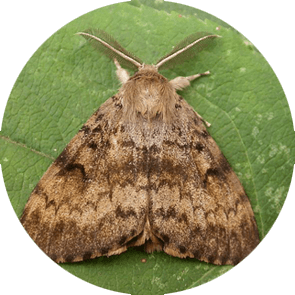


| Latin Name | Lymantria dispar |
| Common Name | Gypsy moth;Spongy moth; |
| Biology | Adult moths exhibit sexual dimorphism: males are strong fliers active during daytime, while females move sluggishly and mostly lay eggs at night, depositing egg masses on tree trunks, branches, or leaves. Larvae are highly polyphagous, feeding on foliage of various trees; during outbreaks they can defoliate entire forests, impairing tree growth or causing mortality. This species produces one generation annually, overwintering as egg masses on trees. |
| Damage | This pest primarily damages multiple forest and fruit trees including poplar, willow, elm, and birch. |
| Distribution Regions | North America and Eurasia |
| Monitoring | Pheromone lures mimic natural sex pheromones to attract male insects into specialized traps for population monitoring and suppression. As a core IPM component, monitoring enables early risk detection and targeted control. Mass trapping reduces mating opportunities to curb offspring populations. Protocols: ●Use only with matched traps. ●15-45 traps/hectare,replace/replenish every 4-6 weeks. ●Wear gloves or wash hands with detergent when switching lure types. ●Refer to trap-specific hanging instructions. |
| Recommended Traps | Delta Trap, Wing Trap |

ご連絡先情報をご提供ください。精密にマッチしたフェロモンソリューションをご提供します。当社の既存ポートフォリオに最適なソリューションが見つからない場合、合成化学チームが分子構造設計から量産まで一貫してカスタム開発を実施いたします。